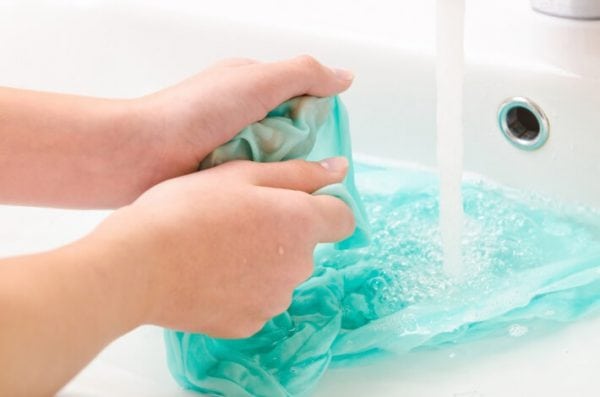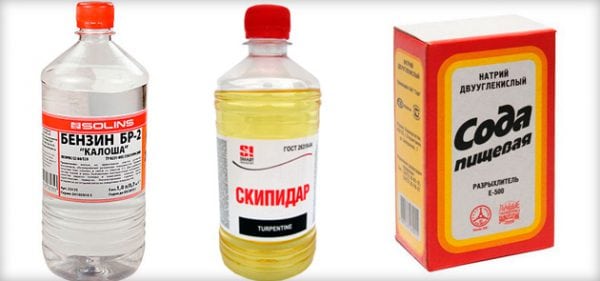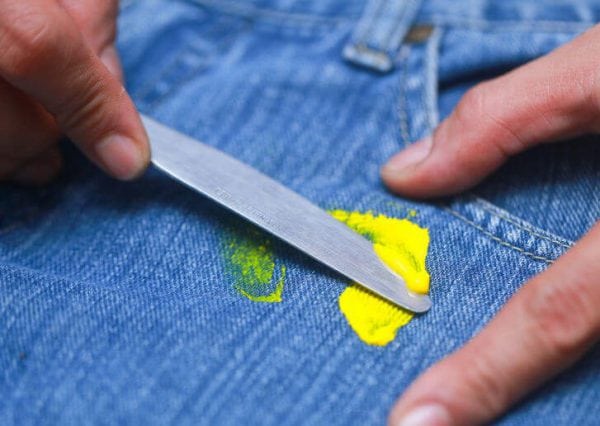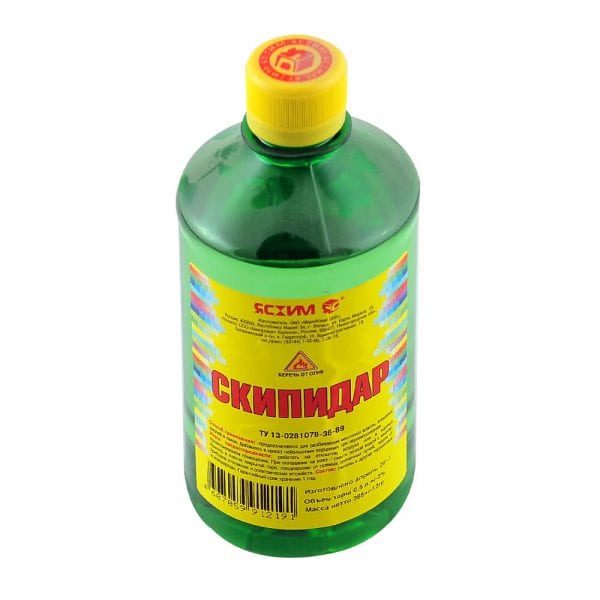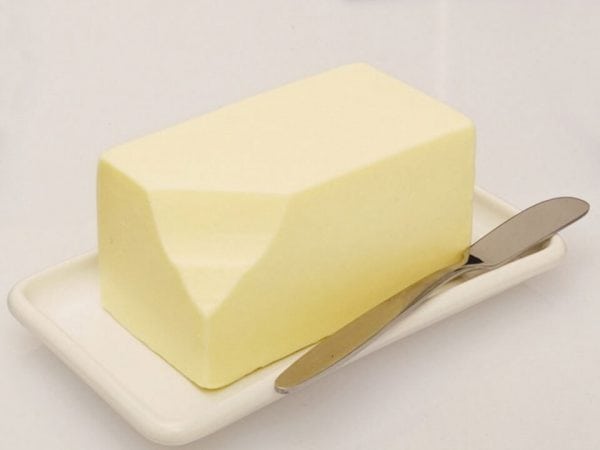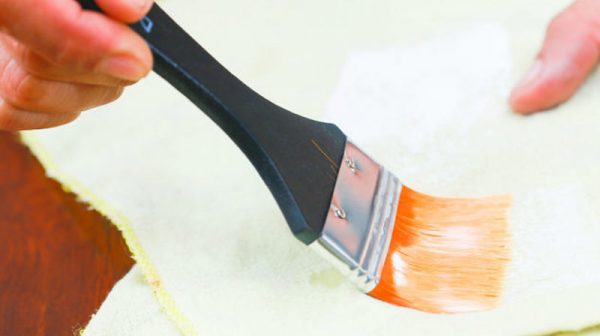Oil paint poses a real danger to clean clothes. During repairs or finishing work, it cannot be guaranteed that oil stains that will be difficult to wash out will not appear on clean clothing of owners or workers. Many believe that it is useless to deal with such spots, but there is a way out. Consider how to wash oil paint from fabrics.
- We remove pollution from clothes
- the washing up
- Cleaning
- Traditional solvents
- Butter
- Special solvents
- Removing oil paint from a brush
- Removing oil paint from the body and face
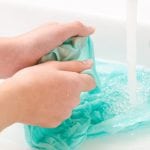
We remove pollution from clothes
According to the degree of contamination of the fabric, the spots are divided into two types:
- easily removable;
- difficult to deduce.
If you are going to remove oil stains from things that have been lying after repair for several months, this is useless. Such clothes should be thrown away right away.
Also, it will not be possible to wash clothes without additional detergents: the paint, as it were, “bites” into the structure of the fabric, filling up the free space.
As detergents or cleaners use:
- laundry soap;
- turpentine;
- solvents for certain types of coatings;
- alcohol, acetone or gasoline;
- folk remedies.
the washing up
If you planted a stain just a few minutes ago, you need to remove it quickly. It is easy to wash completely fresh, still crude stain from oil paint with the help of laundry soap. It is not so toxic as to spoil the fabric, but it is better to be careful: if you are concerned about the effect of caustic soap on your skin, it is better to protect yourself and wear gloves.
You may notice that your attempts to clean the stain are successful right now. It will fade and the clothes will become clean. But if this did not happen, do not despair. Washing a thing is still possible.
to contents ↑If the drop has not yet dried to clean the clothes, it is enough to wash the stain and rinse several times in running water. After that, it is advisable to wash work clothes in the washing machine, but this is not necessary if the initial goal was only to get rid of the stain of oil paint.
Cleaning
If the paint is dry, scrape the stain with a knife. This will help remove the layer without ruining the thing. If it turned out to completely get rid of the stain, it remains only to wash the thing to completely remove the dirt. If not, you will have to use solvents or other chemicals.
This works especially well with denim. It is tough in itself, and paint, even oily, has nothing to “catch on”. Therefore, dried stains will be removed well from jeans and denim jackets.
to contents ↑Traditional solvents
If, after the spots appeared on the clothes, several days passed, it means that the time has come for “heavy artillery”. To remove stains from the fabric will help:
- petrol;
- kerosene;
- turpentine.
Using them, do not lose vigilance. When working with such substances, gloves should be put on hands and kept away from gas or fire if they are present nearby. Before proceeding with stain removal, check how the fabric responds to treatment with gasoline or turpentine. If there is no aggressive reaction, you can proceed to cleanse.
Put a rag or gauze on the wrong side of the dirty place, and soak the other rag in kerosene or gasoline and proceed with hatching.With light but abrupt movements, try to “remove” the stain, but do not rub it even more. Most likely, there will remain stains on the fabric. They are disposed of by washing clothes or treating them with alcohol or a dishwashing detergent.
Similar processing can easily spoil the fabric. Therefore, if you accidentally stained a thing made of delicate fabric, for example, a light silk blouse or dress, it is best to take it to dry cleaning. You are unlikely to succeed on your own paint out. Professionals will do this better, and you will get a clean thing back.
to contents ↑If in a dry cleaning they cannot remove a stain of oil paint, the clothes can definitely be considered lost.
Butter
Among the ways to provide “first aid” to soiled clothes, there is one strange way. To remove the oil stain, it is greased with a thick layer of butter and left for an hour and a half. Then the oil is removed with a sponge soaked in alcohol, and the clothes are washed in warm water. The main thing is to wait until the paint softens, and it can be washed. This requires an hour of waiting.
To enhance the effect, butter is mixed with washing powder or even several, and then apply this mixture to the stain.You should also be careful with this method, because stains may remain on the fabric due to butter. If this happens, the clothes will have to be washed several times.
to contents ↑Special solvents
To wash the paint, you can buy solvents specifically designed for certain types of paints from hardware stores. They are cheap, and they can help you remove oil stains.
As can be seen from the description of how to clean clothes, this will take some time and money, and can even be dangerous. Therefore, if you do not feel the need to clean these clothes, it is better to replace them.
If you often encounter the need to work with oil coatings in connection with repairs or finishing work, get special work clothes that you can easily spoil. It is undesirable to be near paints or other substances that can ruin an expensive thing. Therefore, in repair or construction work it is better to be in work clothes. Then you don’t have to remove the stains using methods hazardous to health.
to contents ↑Removing oil paint from a brush
A brush is required for applying paints to any substrates. Even if the paint is applied with a roller, a brush will still be needed to tint hard-to-reach areas. After completion of work, it is not necessary to throw away the tool - it can be thoroughly cleaned and tidied up until the next use.
For cleaning, it is allowed to use various means. Before starting work, it is important to mechanically remove excess paint from the villi. This is achieved by wiping the brush with a napkin, a cloth.
Then you can choose one of the following methods:
- Laundry soap. It is necessary to take a bar of soap, grate on a coarse grater, dilute the product with warm water. “Drown” the brush in soapy water for half an hour, then rinse it or repeat the procedure if the paint remains.
- Washing powder. Dissolve 50 g of powder (any) in a liter of warm water, soak the brush for 20 minutes. After rinsing out the remaining paint and powder under water.
- Dishwashing liquid. This “drug” is used in a similar manner. So much is added per liter of water so that a strong foam is formed.
All of these methods are important to apply, while the paint has not yet hardened. Otherwise, only special solvents selected for a specific type of coatings will help.
If solvent is not available, vinegar is useful. You need to take a 9% table solution, pour into a narrow container, immerse the brush for an hour. If necessary, this time is extended for another hour.In the absence of effect, vinegar with a brush is simmered for 5 minutes, then the instrument is washed and the bristles are combed with an unnecessary comb. To keep the brush soft after the manipulations, you can soak it for a while in the fabric softener.
to contents ↑Removing oil paint from the body and face
Often, spots of paint appear on the skin, which happens when personal protective measures are not followed during painting. Paint can get on hands through torn gloves, and splashes are often on the face. Paint should be removed without waiting for it to dry.
The skin on the face is delicate; it is not worth rubbing it too much. It is usually recommended to use oil products - oil-based cosmetic fluids, peach oil (if they are not present, take ordinary edible oil). The tool can moisten the swab and easily wipe off any type of paint. After you need to wash with glycerin soap or any means for washing.
Hands can be washed with toilet or laundry soap, which copes with fresh traces of paint. By the same means they cleanse the skin on the body if drops of paint and varnish get into it.
When the paint dries, the soap and oil often do not cope - more aggressive methods will be required. Acetone or acetone based nail polish remover helps. It is important to wipe it off quickly and immediately wash off the acetone with soap and water, otherwise there is a risk of burns, allergies, irritation.

